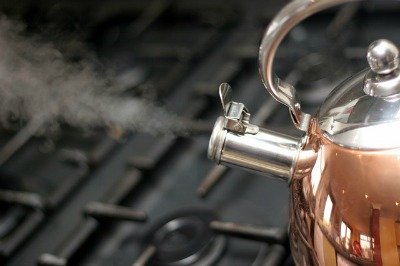4. Water has a high heat of vaporization and boiling point.
Water has the unique property of being able to exist in either of three states: solid, liquid, and gas or steam or water vapor.
The transformation from one to another involves changes in hydrogen bonding and energy levels.
The rule applies that “energy is required for a bond to form, and energy is released when a bond is broken” (Mader 1993).
However, despite its low molecular weight (m.w.= 18.02), water is a liquid at ordinary temperatures and pressure; it does not readily change to ice or steam.
Due to hydrogen bonding, water molecules cling to each other (cohesion) and remain in a liquid state under temperatures that are favorable to plants and other living organisms.
Liquid water has a boiling temperature of 100°C and freezes at 0°C at 1 atmospheric pressure.
When it boils, the hydrogen bonds are broken and the molecules separate from each other.
But without these hydrogen bonds, water will boil at a temperature of -80°C and freeze at -100°C (Mader 1993).

The hydrogen-bonding property of water is therefore vital to life, particularly to plants that generally survive within a temperature range from 0 to 50°C (click to read source page).
Otherwise, plants will be deprived of liquid water because the water inside will change to gas even at low temperatures.
In contrast, most other compounds with low molecular weights exist as gases at room temperature.
For example, methane (CH4, m.w.= 16.04), ammonia (NH3, m.w.= 17.03), and hydrogen sulfide (H2S, m.w.= 34.08) boil at -162°C, -33°C, and -61°C, respectively.
Their melting points are correspondingly lower at -182°C, -78°C, and -86°C, respectively (Mathews and van Holde 1990).
In the process of changing 1 gram of liquid water at 0°C to solid form or ice at 0°C, 80 calories of heat energy are lost.
This is the latent heat of the fusion of water.
The heat that is given off when water freezes keep the atmospheric temperature higher.
Likewise, 1 gram of ice at 0°C uses 80 calories of heat energy to convert to 1 gram of liquid water at 0°C.
This is water’s latent heat of melting.
But a very high quantity of heat energy is needed for evaporation. This amount of heat is called heat of vaporization.
When molecules of water absorb heat energy, they move fast in the water.
Eventually, the speed of movement of some molecules becomes so fast allowing them to overcome the intermolecular attraction, detach from the multimolecular water, form bubbles, and leave the water surface in the gas state.
Water has a latent heat of vaporization of 540 calories per gram, the amount of heat energy that is necessary to convert 1 g of liquid water at 100°C to steam at 100°C, or 40.71 kJ/mol or about 2,260 kJ/kg water.
The heat energy is used in breaking the hydrogen bonds which hold the molecules of liquid water together.
For comparison, the heats of vaporization of methane, ammonia, and hydrogen sulfide are 8.16 kj/mol (equivalent to 121.59 cal/g), 23.26 kj/mol (326.44 cal/g), and 18.66 kj/mol (130.86 cal/g), respectively.
The values in kJ/mol (referred to as the molar heat of vaporization) were obtained from Mathews and Van Holde (1990) while the parenthesized equivalents are mathematical derivations by the herein author.
It is clear that water has a higher heat of vaporization, and so with the boiling points and melting or freezing points.
This property of water helps to cool down the body of living organisms.
This is called evaporative cooling.
In humans, body heat is used to vaporize sweat; in plants, heat is likewise used in converting liquid water to water vapor which then escapes into the atmosphere.
This natural process of vaporizing plant water is called transpiration.

Great article to suggest to others! Thanks!
“But without these hydrogen bonds, water will boil at a temperature of -80°C and freeze at -100°C (Mader 1993).”
May have a link or citation?